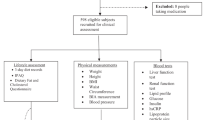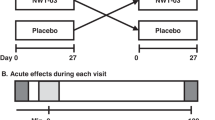Abstract
Objective:
To assess the effects of consuming foods containing oat β-glucan on blood pressure, carbohydrate homeostasis and biomarkers of oxidative stress.
Design:
A randomized, double-blind, controlled clinical trial.
Setting:
The trial was conducted at two clinics.
Subjects and interventions:
Ninety-seven men and women with resting systolic blood pressure 130–179 mm Hg and/or diastolic blood pressure 85–109 mm Hg were randomly assigned to consume foods containing oat β-glucan or control foods for 12 weeks. Resting blood pressures, insulin and glucose values before and after standard breakfast meals, and four biomarkers of oxidative stress were measured before and at the end of the treatment period.
Results:
Changes from baseline to week 12 in mean peak insulin and incremental area under the insulin curve differed significantly between groups (P=0.037 and 0.034, respectively), with the β-glucan group showing declines and the control group remaining essentially unchanged. Blood pressure responses were not significantly different between groups overall. However, in subjects with body mass index above the median (31.5 kg/m2), both systolic (8.3 mm Hg, P=0.008) and diastolic (3.9 mm Hg, P=0.018) blood pressures were lowered in the β-glucan group compared to controls. No significant differences in biomarkers of oxidative stress were observed between treatments.
Conclusions:
The results of the present trial suggest beneficial effects of foods containing β-glucan from oats on carbohydrate metabolism, and on blood pressure in obese subjects.
Sponsorship:
Funding for this study was provided by the Quaker Oats Company.
This is a preview of subscription content, access via your institution
Access options
Subscribe to this journal
Receive 12 print issues and online access
$259.00 per year
only $21.58 per issue
Buy this article
- Purchase on Springer Link
- Instant access to full article PDF
Prices may be subject to local taxes which are calculated during checkout

Similar content being viewed by others
References
Bazzano LA, He J, Ogden LG, Loria CM, Whelton PK (2003). Dietary fiber intake and reduced risk of coronary heart disease in US men and women. Arch Intern Med 163, 1897–1904.
Brancati FL, Appel LJ, Seidler AJ, Whelton PK (1996). Effect of potassium supplementation on blood pressure in African Americans on a low-potassium diet: a randomized, double-blind, placebo-controlled trial. Arch Intern Med 156, 61–67.
Burke V, Hodgson JM, Beilin LJ, Giangiulioi N, Rogers P, Puddey IB (2001). Dietary protein and soluble fiber reduce ambulatory blood pressure in treated hypertensives. Hypertension 38, 821–826.
Calle-Pascual A, Garcia-Honduvilla J, Martin-Alvarez PJ, Calle JR, Maranes JP (1996). Influence of 16-week monotherapy with acarbose on cardiovascular risk factors in obese subjects with non-insulin-dependent diabetes mellitus: a controlled, double-blind comparison study with placebo. Diabetes Metab 22, 201–202.
Chen CY, Milbury PE, Kwak HK, Collins FW, Samuel P, Blumberg JB (2004). Avenanthramides and phenolic acids from oats are bioavailable and act synergistically with vitamin C to enhance hamster and human LDL resistance to oxidation. J Nutr 134, 1459–1466.
Chiasson JL, Josse RG, Gomis R, Hanefeld M, Karasik A, Laakso M (2002). Acarbose for prevention of type 2 diabetes mellitus: the STOP-NIDDM trial. Lancet 359, 2072–2077.
Chiasson JL, Josse RG, Gomis R, Hanefeld M, Karasik A, Laakso M (2003). Acarbose treatment and the risk of cardiovascular disease and hypertension in patients with impaired glucose tolerance. JAMA 290, 486–494.
Chiasson JL, Josse RG, Leiter LA, Mihic M, Nathan DM, Palmason C et al. (1996). The effect of acarbose on insulin sensitivity in subjects with impaired glucose tolerance. Diabetes Care 19, 1190–1193.
Chiasson JL, Naditch L (2001). The synergistic effect of miglitol plus metformin combination therapy in the treatment of type 2 diabetes. Diabetes Care 24, 989–994.
Collins FW (1986). Oat phenolics: structure, occurrence and function. In: FH Webster (ed). Oats: Chemistry and Technology. Am Assoc Cereal Chemists: St Paul, MN, pp 227–295.
Davy BM, Melby CL, Beske SD, Ho RC, Davrath LR, Davy KP (2002). Oat consumption does not affect resting casual and ambulatory 24-h arterial blood pressure in men with high-normal blood pressure to stage I hypertension. J Nutr 132, 394–398.
Ebeling P, Yki-Jarvinen H, Aro A, Helve E, Sinisalo M, Koivisto VA (1998). Glucose and lipid metabolism and insulin sensitivity in type 1 diabetes: the effect of guar gum. Am J Clin Nutr 48, 98–103.
Fonseca VA (2003). Management of diabetes mellitus and insulin resistance in patients with cardiovascular disease. Am J Cardiol 92, 50J–60J.
Griendling KK, Sorescu D, Ushio-Fukai M (2000). NAD(P)H oxidase: role in cardiovascular biology and disease. Circ Res 86, 494–501.
Groop PH, Aro A, Stenman S, Groop L (1993). Long-term effects of guar gum in subjects with non-insulin-dependent diabetes mellitus. Am J Clin Nutr 58, 513–518.
Haffner S, Taegtmeyer H (2003). Epidemic obesity and the metabolic syndrome. Circulation 108, 1541–1545.
He J, Klag MJ, Whelton PK, Mo JP, Chen JY, Qian MC et al. (1995). Oats and buckwheat intakes and cardiovascular disease risk factors in an ethnic minority of China. Am J Clin Nutr 61, 366–372.
Heyward V (1984). Designs for Fitness. A Guide to Physical Fitness Appraisal and Exercise Prescription. Macmillan Publishing Company: New York,pp 111–114.
Jain SK, McVie R, Duett J, Herbst JJ (1989). Erythrocyte membrane lipid peroxidation and glycosylated hemoglobin in diabetes. Diabetes 38, 1539–1543.
Jenney A, Proietto J, O'Dea K, Nankervis A, Traianedes K, D'Embden H (1993). Low-dose acarbose improves glycemic control in NIDDM patients without changes in insulin sensitivity. Diabetes Care 16, 499–502.
Keaney Jr JF, Larson MG, Vasan RS, Wilson PWF, Lipinska I, Corey D et al. (2003). Obesity and systemic oxidative stress. Clinical correlates of oxidative stress in the Framingham Study. Arterioscler Thromb Vasc Biol 23, 434–439.
Keenan JM, Pins JJ, Frazel C, Moran A, Turnquist L (2002). Oat ingestion reduces systolic and diastolic blood pressure in patients with mild or borderline hypertension: a pilot trial. J Fam Pract 51, 369.
Landin K, Holm G, Tengborn L, Smith U (1992). Guar gum improves insulin sensitivity, blood lipids, blood pressure, and fibrinolysis in healthy men. Am J Clin Nutr 56, 1061–1065.
Landsberg L (1999). Role of the sympathetic adrenal system in the pathogenesis of the insulin resistance syndrome. Ann NY Acad Sci 892, 84–90.
Lin PH, Aickin M, Champagne C, Craddick S, Sacks FM, McCarron P et al. (2003). Food group sources of nutrients in the dietary patterns of the DASH-sodium trial. J Am Diet Assoc 103, 488–496.
Maki KC (2004a). Dietary factors in the prevention of diabetes mellitus and coronary artery disease associated with the metabolic syndrome. Am J Cardiol 93 (Suppl), 12C–17C.
Maki KC (2004b). Fibrates for treatment of the metabolic syndrome. Curr Atheroscler Rep 6, 45–51.
Meneilly GS, Ryan EA, Radziuk J, Lau DC, Yale JF, Morais J et al. (2000). Effect of acarbose on insulin sensitivity in elderly patients with diabetes. Diabetes Care 23, 1162–1167.
National Cholesterol Education Program Expert Panel (2002). Third Report of the National Cholesterol Education Program Expert Panel on Detection, Evaluation and Treatment of High Cholesterol in Adults (Adult Treatment Panel III): Final Report. National Heart, Lung and Blood Institute, National Institutes of Health Publication number 02-5215.
National High Blood Pressure Education Program (2003). The seventh report of the Joint National Committee on Prevention, Detection, Evaluation, and Treatment of High Blood Pressure. National Institutes of Health Publication Number 03-5233.
Peterson DM, Qureshi AA (1993). Genotype and environment effects on tocols of barley and oats. Cereal Chem 70, 157–162.
Pins JJ, Geleva D, Keenan JM, Frazel C, O'Connor PJ, Cherney LM (2002). Do whole grain oat cereals reduce the need for antihypertensive medications and improve blood pressure control? J Fam Prac 51, 353–359.
Reaven GM, Lardinois CK, Greenfield MS, Schwartz HC, Vreman HJ (1990). Effect of acarbose on carbohydrate and lipid metabolism in NIDDM patients poorly controlled by sulfonylureas. Diabetes Care 13 (Suppl), 32–36.
Reaven GM, Lithell H, Landsberg L (1996). Hypertension and associated metabolic abnormalities. N Engl J Med 334, 374–381.
Sallis JF, Haskell WL, Wood PD, Fortmann SP, Rogers T, Blair SN et al. (1985). Physical activity assessment methodology in the Five-City Project. J Epidemiol 121, 91–106.
Saltzman E, Das SK, Lichtenstein AH, Dallal GE, Corrales A, Schaefer EJ et al. (2001). An oat-containing hypocaloric diet reduces systolic blood pressure and improves lipid profile beyond effects of weight loss in men and women. J Nutr 131, 1465–1470.
Schnack C, Prager RJ, Winkler J, Klauser RM, Schneider BG, Schernthaner G (1989). Effects of 8-wk alpha-glucosidase inhibition on metabolic control, C-peptide secretion, hepatic glucose output, and peripheral insulin sensitivity in poorly controlled type II diabetic patients. Diabetes Care 12, 537–543.
Scott CL (2003). Diagnosis, prevention, and intervention for the metabolic syndrome. Am J Cardiol 92 (Suppl), 35i–42i.
U.S. Department of Health and Human Services (1996). Guidance for industry: E6 Good clinical practice: Consolidated guidance. Food and Drug Administration Publication Number 959fnl.
Whelton PK, Kumanyika SK, Cook NR, Cutler JA, Borhani NO, Hennekens CH et al. (1997). Efficacy of nonpharmacologic interventions in adults with high-normal blood pressure: results from phase 1 of the Trials of Hypertension Prevention. Trials of Hypertension Prevention Collaborative Research Group. Am J Clin Nutr 65 (Suppl), 652S–660S.
Wolever TM, Jenkins DJ, Jenkins AL, Josse RG (1991a). The glycemic index: methodology and clinical implications. Am J Clin Nutr 54, 846–854.
Wolever TM, Vuksan V, Eshuis H, Spadafora P, Peterson RD, Chao ES et al. (1991b). Effect of method of administration of psyllium on glycemic response and carbohydrate digestibility. J Am Coll Nutr 10, 364–371.
Yamamoto ME, Applegate WB, Klag MJ, Borhani NO, Cohen JD, Kirchner KA et al. (1995). Lack of blood pressure effect with calcium and magnesium supplementation in adults with high normal blood pressure. Results from Phase I of the Trials of Hypertension Prevention (TOHP). Trials of Hypertension Prevention (TOHP) Collaborative Research Group. Ann Epidemiol 5, 96–107.
Acknowledgements
We gratefully acknowledge statistical and technical support from Marjorie Bell, Denise Umporowicz and Kimberly Oldham.
Author information
Authors and Affiliations
Corresponding author
Additional information
Supplementary Information accompanies the paper on European Journal of Clinical Nutrition website (http://www.nature.com/ejcn)
Supplementary information
Rights and permissions
About this article
Cite this article
Maki, K., Galant, R., Samuel, P. et al. Effects of consuming foods containing oat β-glucan on blood pressure, carbohydrate metabolism and biomarkers of oxidative stress in men and women with elevated blood pressure. Eur J Clin Nutr 61, 786–795 (2007). https://doi.org/10.1038/sj.ejcn.1602562
Received:
Revised:
Accepted:
Published:
Issue Date:
DOI: https://doi.org/10.1038/sj.ejcn.1602562
Keywords
This article is cited by
-
Dietary fibre in hypertension and cardiovascular disease management: systematic review and meta-analyses
BMC Medicine (2022)
-
Effect of oat supplementation interventions on cardiovascular disease risk markers: a systematic review and meta-analysis of randomized controlled trials
European Journal of Nutrition (2022)
-
Fucoidan-rich Sargassum wightii extract supplemented with α-amylase improve growth and immune responses of Labeo rohita (Hamilton, 1822) fingerlings
Journal of Applied Phycology (2019)
-
Evaluation of Major Dietary Ingredients in Diverse Oats (Avena sativa L.) Germplasm
Journal of Crop Science and Biotechnology (2019)
-
The effect of moderate weight loss, with or without (1, 3)(1, 6)-β-glucan addition, on subcutaneous adipose tissue inflammatory gene expression in young subjects with uncomplicated obesity
Endocrine (2018)



